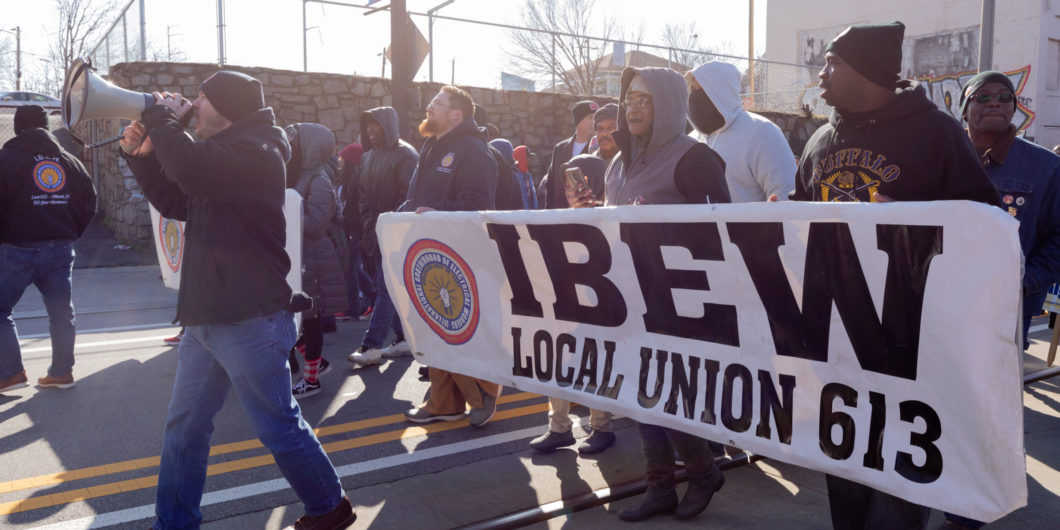Embracing stakeholder capitalism on a global scale would only magnify the already-yawning gap between Davos man and everyone else.
Crony Capitalism & the Case for Labor Unions
L &L Contributing Editor Mark Pulliam recently wrote on “The Exploitation of Labor and Other Union Myths” for The Independent Review. He posted an abridged version of his argument here at L&L. I accept the bulk of his analysis given his assumption of “the existence of competition among uncoerced market participants.” But this is a crucial assumption for his analysis. If this assumption is relaxed, however, and we remember that significant amounts of government-sponsored “crony capitalism” exist in the United States, then there is a prudential, conservative case for granting legal privileges to private-sector labor unions in collective bargaining. (Government-sector unions are a different matter. And union activities outside of collective bargaining, such as using union dues for political campaigns, are a different matter.)
A couple of definitions and a bit of brush clearing to set the stage.
First, economists define “normal profit” as the amount of profit necessary to induce an entrepreneur to start and run a business. Normal profit is thought of as a “cost” because it is analogous to a wage. It’s not actually a wage because it’s the boss who gets normal profit. But normal profit is like the cost of a wage because it’s pay to the entrepreneur for labor in running the firm. Without normal profit, the entrepreneur just won’t work at the job of running the company.
“Economic profit,” on the other hand, is profit in excess of normal profit.
The Role of Profit
Economic profit can be a good thing. Its existence provides incentives to entrepreneurs to enter underserved markets and even to create new markets where none existed before. But once entrepreneurs enter the market, price competition soon drives economic profit down to zero, and they earn only normal profit after that. (Think for example of the 3 percent margin for the very competitive markets in which Target and Walmart compete, versus much higher margins for companies in low-competition environments.)
To put this another way, competitive markets socialize economic profit. When markets are competitive, price competition among businesses results in them giving away all their economic profit to the rest of us, the consumers, in the form of lower prices. Businesses don’t like to do this, but they do so voluntarily nonetheless. That’s the genius of markets. It induces profit-maximizing actors voluntarily to give away to the rest of us what they would very much prefer to keep for themselves.
Secondly, in a competitive market there is nothing that a labor union can do to increase workers’ wages. If the union demands a greater-than-competitive wage, the company cannot increase its price to pay for it because consumers would then buy from the other firms that sell at a lower price because they pay the competitive wage. The company would go out of business. So, too, the wage increase can’t come from the entrepreneur’s normal profit, because that is the minimum amount needed to induce the entrepreneur to use his or her skills to lead and manage the company. Reduce normal profit and the entrepreneur will cashier the business.
So even when unions exist in a competitive market, wages will be what they would have been without the union. This is why unions in competitive markets are weak. There is simply no economic profit for capital or labor to divvy up in competitive markets; all of the economic profit, as it were, gets transferred to the consumer in the form of lower prices. Competitive markets socialize economic profit. (To be sure, there is some room even in a competitive market for unions to act as a centralized clearing house or monitor on important issues like worker safety. But there is no room for a union to affect wages in a competitive market.)
Thirdly, as I mentioned above, whatever their charitable inclinations, entrepreneurs would prefer not be forced to give away their economic profit to the rest of society. In a competitive market there’s not much entrepreneurs can do to prevent the socialization of their economic profit. But entrepreneurs can receive economic profit if they can somehow get the government to intervene on their side and restrict competition in the market.
Cronies Everywhere
The process by which business seeks government intervention to sustain long-term economic profit is called “rent seeking.” The outcome of successful rent seeking is “crony capitalism,” that is, when the government intervenes on behalf of business to allow it to sustain economic profit.
There is a long tradition in public choice scholarship—”conservative” economics—identifying incentives business has for rent-seeking, that is, to “invest” resources in search of political and governmental intervention that will return economic profits to them. Recent books discussing the topic include The Captured Economy (2017) and The Great Reversal: How America Gave up on Free Markets (2019).
The existence of crony capitalism is not an all-or-nothing affair. Crony capitalism can exist alongside a robust competitive sector. This is called a “dual economy.” In the crony sector economic profits exist; in the competitive sector economic profits do not exist. In the competitive sector putative economic profits get dissipated to everyone through lower prices. In the crony sector, business owners are able to keep economic profits for themselves.
Mark Pulliam analyzes the effect of labor unions assuming competitive markets. The existence of crony capitalist markets in which government intervention restricts competitive outcomes necessarily changes the analysis.
Here, then, is a prudential case for labor unions in the type of economy we have today.
Not the Best Possible World
To be sure, the first-best solution to crony capitalism would be to eliminate government intervention in favor of select businesses so that they would not realize economic profits at the expense of everyone else. But we can make the practical political judgment that the first-best solution is not available to us in current circumstances. Rent-seeking exists, it’s in the interests of politicians and (some) businesses that it continue, and it will continue no matter that many would prefer that it not.
But if the first-best solution is not really available to us as a practical political matter, does that mean we just need to suck it up and allow governmentally-protected capital to enjoy economic profits in excess of normal profits, profits that otherwise would be distributed to the rest of us in the form of lower prices?
Just because all of us won’t share in a protected firm’s economic profits doesn’t mean that none should share in those profits. By creating legally-privileged labor unions, owners of protected firms would have to share at least some of their economic profits with their employees. Given that businesses shouldn’t be enjoying government-created economic profits to begin with, there’s no harm in developing institutions, such as labor unions, as a second-best adaptation to the existence of crony capitalism. Unions result in the distribution of some economic profit to workers in those businesses rather than allowing the owners to keep all of it. That is one reason unions are associated with less economic inequality.
Again, this is not a first-best solution to crony capitalism. It can be a second-best solution, however, if the first-best solution is not available to us as a practical political matter. (And it’s not.)
One obvious objection is that creating legally-empowered labor unions to remediate the effects of crony capitalism would just make things worse. But it depends on our judgment regarding the possibility of crafting a working political coalition to eliminate crony capitalism relative to crafting a working political coalition to create institutions that would remediate even some of the ill effects of crony capitalism.
The Art of the Possible
Given what exists today, and what has existed for the last century in the U.S., the probability of successfully forming a political coalition that would systematically root out crony capitalism in the U.S. political system is close to zero. On the other hand, successful political coalitions supporting labor unions existed in the past, and continue today (albeit in a weakened form).
The thing is, the perfect need not be the enemy of the good. That labor unions promote inefficiencies and violate property rights in classically liberal economies does not entail that they cause equivalent harm in economies that deviate significantly from conditions of a classically liberal economy due to government intervention on the side of politically-connected capital.
There is another objection. I noted above that the economy has a competitive sector as well as a “crony” sector. While we might allow capital and labor to squabble over the distribution of economic profit in the crony sector of the economy, unions would still be inappropriate institutions in the competitive sector of the economy. But recall: In competitive markets, unions simply cannot alter outcomes between capital and labor. Capital receives normal profit in competitive markets—the amount just necessary to attract it to the market. Prices cannot go up and the return to capital cannot go down without firms going out of business. Basically, there’s nothing to fear from unions in competitive markets. There’s nothing they can do; they’re inherently weak.
Related to this is the question whether the dramatic decline in private-sector union membership since its apex in the 1940s and 1950s suggests that unions are simply failing the market test. It is possible that unions simply do not provide what private-sector workers want or need any more. But we should not rush to that conclusion a priori. Recall my argument, that unions are inherently weak in competitive markets; they can affect wages only when economic profits exist. But economic profits exist (beyond the short-run) only in cases of crony capitalism, when the government intervenes on behalf of politically-connected businesses.
There is an alternative hypothesis. Consider that crony capitalists do not want to share their government-induced economic profits with union members any more than they want to share it with consumers at large. Given that, by definition, crony capitalism results from politically-connected businesses, it is no stretch that crony capitalists use the same political power to change labor laws, and thereby decrease the need to share economic profits with union employees. Consistent with this, after a sharp and significant increase in union membership after the adoption of National Labor Relations Act (NRLA) in 1935, union membership in the private sector started its long decline with adoption of Taft-Hartley Act in 1947. This act limited powers statutorily granted to unions earlier in the NLRA.
Pulliam discusses the mischief labor unions cause in classical liberally economies. But we don’t have a classically liberal economy in the U.S. today. We live in a mixed economy in which rent-seeking businesses induce government intervention on their behalf. The government wouldn’t be doing that in classically liberal economies. But tsk, tsking crony capitalism is not the only response conservatives can make in response to the problem of crony capitalism. In a second-best world, sometimes second-best solutions are optimal given the options realistically available. It seems to me legally-privileged labor unions are one of those possibilities given the current political and economic climate in the U.S.



